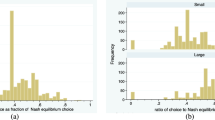Abstract
Laboratory subjects repeatedly played one of two variations of a simple two-person zero-sum game of “hide and seek”. Three puzzling departures from the prescriptions of equilibrium theory are found in the data: an asymmetry related to the player’s role in the game; an asymmetry across the game variations; and positive serial correlation in subjects’ play. Possible explanations for these departures are considered.
Similar content being viewed by others
Author information
Authors and Affiliations
Corresponding author
Additional information
We are grateful to Todd Swarthout for invaluable research assistance and to Kevin Lang, Mark Machina, and John Wooders for helpful comments. Some of the work was done while Rosenthal was visiting the Department of Economics at MIT and the Department of Political Economy at the University of Siena and while Shachat was on the faculty of the University of California at San Diego. All three authors are grateful to the National Science Foundation for financial support of this research.
See, for example, Rapoport and Boebel (1992), Mookherijee and Sopher (1994, 1997), Bloomfield (1994), Ochs (1994), Shachat (2002), and Binmore, et al. (2001). See also Brown and Rosenthal (1990) and O’Neill (1991) for an analysis and discussion of the extent to which the data support the theory.
Rights and permissions
About this article
Cite this article
Rosenthal, R., Shachat, J. & Walker, M. Hide and seek in Arizona. Int J Game Theory 32, 273–293 (2003). https://doi.org/10.1007/s001820300159
Revised:
Issue Date:
DOI: https://doi.org/10.1007/s001820300159




